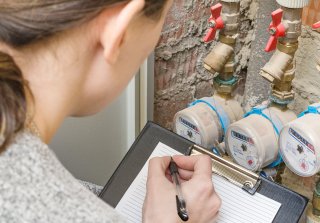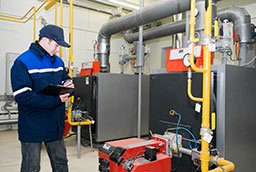Getting Started

Over the past few decades, the costs of water and wastewater services have risen at a rate well above the consumer price index. Facility managers can expect these and other utility costs to continue to increase in order to offset the costs of replacing aging water supply systems within their communities. As a result, businesses are becoming increasingly more aware of the need to manage and use water more efficiently to reduce operating costs; energy needed to heat, store, and deliver water; and the risk of water shortages.
On This Page:
Making the Business Case

Carrying out and communicating water efficiency efforts can position companies and facility managers as leaders in their community who are helping to improve sustainability—and earn them recognition in the green marketplace. By implementing water-efficient best management practices, commercial and institutional facilities have an opportunity to:
- Achieve cost savings
- Increase competitive advantage
- Reduce risks associated with water scarcity
- Demonstrate leadership
- Access opportunities in the green building marketplace
Section 1.1 of WaterSense at Work highlights some of the benefits of water efficiency for commercial and institutional facilities. Read about the experiences of Providence Hospital in Olympia, Washington.
- How Hospitals Can Save Water and Big Bucks Too (Providence Hospital is also featured in a WaterSense case study)
Planning
Effective water management starts with planning. To achieve water management goals, facilities should consider forming water management teams to evaluate water use, develop implementation plans, measure progress, make ongoing improvements, and identify new savings goals and opportunities.
The Commercial Tools page includes sample worksheets and water assessment resources that can help with water management planning.
Water management planning generally addresses water use reductions in four areas:
- Reducing water losses (e.g., leaks).
- Increasing the water efficiency of fixtures, equipment, systems, and processes.
- Educating employees and occupants about water efficiency to encourage water-saving behaviors.
- Reusing onsite alternative water that would otherwise be discarded or discharged to the sewer (e.g., reusing treated graywater or rainwater to water landscape areas).
Water management planning follows the same framework used in the ENERGY STAR Guidelines for Energy Management, which consists of these basic steps:
- Step 1. Make a commitment
- Step 2. Assess facility water use
- Step 3. Set and communicate goals
- Step 4. Create an action plan
- Step 5. Implement the action plan
- Step 6. Evaluate progress
- Step 7. Recognize achievement
Periodic reviews of plans by the water management team can demonstrate and promote the success of the water management program, which can provide long-term support for the program and future projects and initiatives. Section 1.2: Water Management Planning of WaterSense at Work provides information about best practices for water management planning.
Metering

You can't manage what you don't measure. Using meters and submeters as measurement tools, facility managers can:
- Identify areas for targeted reductions in water use
- Find and fix leaks and identify malfunctioning equipment
- Identify opportunities to increase water savings
- Track savings from water efficiency projects
Meters and submeters can be integrated into a centralized building management system, making it easy to track usage and implement a water management plan. These systems can store data from meters and submeters, reporting hourly, daily, monthly, and annual water use. They can also trigger alerts when leaks or other operational anomalies are detected.
NOTE: Submeters and temporary flow meters do NOT need to be on separate utility accounts; they can just be used internally to pinpoint issues.
Installing the correct meter and making sure it functions properly are critical to accurate water measurement. There are many different types and sizes of meters, so it is important to choose the correct one. Section 2.1: Metering and Submetering of WaterSense at Work provides information about best practices for meter selection and use.
Many utilities are transitioning to Advanced Metering Infrastructure (AMI) to more easily collect water usage data, support customer billing, and better manage water resources. AMI facilitates collection and communication of more frequent (e.g., hourly) water use data that can help facility managers better understand water usage and identify leaks. Review WaterSense's AMI guide for facility managers to learn more about the benefits.
Leaks
When looking for water savings opportunities, leaks should be a first area to target. On average, leaks can account for more than 6 percent of a facility’s total water use. Leaks and continuously running water may not always be visible, but they can add up quickly and become a major cost in water and energy bills. As described in the table at the bottom of this page, water leaks can add up over time.

To find leaks and other water waste, start by gathering information to track your water and energy usage. Read your water meters and submeters to identify problems and usages spikes before you get a high bill. Set up alerts to detect leaks and failures on all water-using equipment such as cooling towers and boiler systems. Add leak detection to your daily rounds and engage your staff, visitors, and tenants to report leaks.
Dive into your facility’s water use using one of WaterSense’s checklists to help identify leaks in your facility.
Learn more best practices in Section 2.2: Leak Detection and Repair of WaterSense at Work.
To engage your employees and visitors in finding and fixing leaks, you can participate in WaterSense’s Fix a Leak Week held in March of each year and use many of the ideas year-round. While the events are often focused on residential leaks, there are many ways to bring Fix a Leak Week to your facility:
- Host a Fix a Leak Week event in your facility to challenge employees and tenants to find leaks and report water waste.
- Find out if your local utility is celebrating Fix a Leak Week or if they would be willing to send someone to help with your event.
- Put up signs in restrooms and kitchens with maintenance staff contact information to prompt everyone to look for leaks and report problems. WaterSense has also developed some graphic tools you can use to communicate with employees.
- Include leak detection and water-saving tactics in regular staff trainings and all service and vendor contracts.
- Communicate the water-saving message to outsourced cleaning, housekeeping, maintenance, and landscaping staff as well as tenants to reach everyone.
- Keep track of leaks and waste identified so you can estimate water savings. Use this success to encourage employees to continue to look for leaks and wasted water throughout the year.
For more ideas, check out our Fix a Leak Week information including other leak materials and a map of events.
Potential Losses From Water Leaks
| Malfunction | Leaking Flow Rate (gallons per minute) | Water Loss | Estimated Cost of Water Loss |
|---|---|---|---|
|
Leaking Toilet - Small (e.g., worn flapper) |
0.02 gpm | 860 gallons per month | Up to $10 per month |
| Leaking Toilet - Medium ( e.g., misaligned flapper) | 0.2 gpm | 8,600 gallons per month | Up to $95 per month |
| Leaking Toilet - Large (e.g., stuck fill valve) | 3.0 gpm | 4,300 gallons per day | Up to $1,400 per month |
| Drip Irrigation Malfunction | 1.0 gpm | 43,200 gallons per month | $5,700 per year |
| Unattended Water Hose at Night | 10.0 gpm | 5,400 gallons per day | $60 per day |
| Broken Distribution Line For: One Night One Day One Week One Month |
15.0 gpm 15.0 gpm 15.0 gpm 15.0 gpm |
8,100 gallons 21,600 gallons 151,200 gallons 648,000 gallons |
Up to $7,200 per month |
| Tempering Water Line on a Steam Sterilizer Stuck in the On Position | 2.0 gpm | 86,400 gallons per month | $11,500 per year |
| Stuck Float Valve in a Cooling Tower | 5.0 gpm | 216,000 gallon per month | $29,000 per year |
